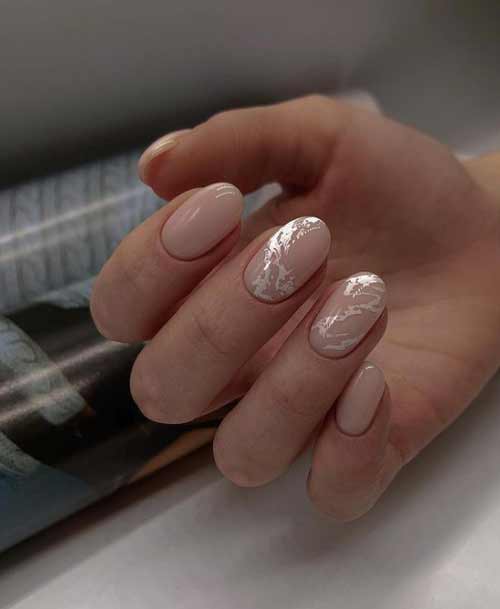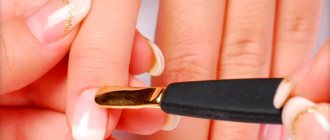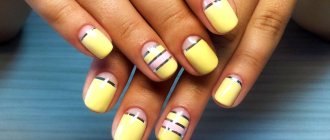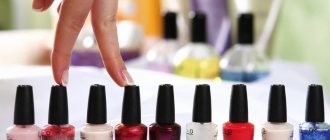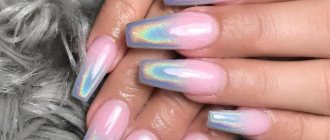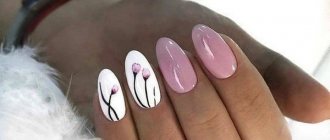Modern nail art has an amazing manicure design technology - watercolor painting. This nail decor costs more than a regular manicure. But his beauty simply amazes the hearts of many fashionistas. The high price of watercolor painting is explained by the fact that the material itself and the skill of the master have significant costs. We suggest we talk a little about the technology of watercolor painting itself and what is needed for this technology.
What is watercolor painting in manicure, what does it look like?
Watercolor painting represents images of various subjects with a blur effect. Translucent strokes give the design a feeling of lightness, and multi-layering adds volume and dynamics. There are several techniques for creating watercolors, which differ in the properties of the materials used.

Visually, painted designs may differ, so each master can find and master a convenient way to create drawings.
Floral motifs
A design with floral motifs will help you pay tribute to trends and create the most feminine nail art. Tulips, peonies, daisies, roses, dandelions and other flowers look especially fabulous and realistic using painting techniques.

Fashionistas were faced with a difficult choice - to create complex floral compositions in manicures or opt for minimalist accents in combination with a single-color coating. Both options are currently at the peak of popularity and look great.
Watercolor painting techniques
Watercolor on nails can be done step by step using several techniques.
Depending on the materials used, there are 3 methods:
- “dry” or blur technique;
- painting with gel polishes;
- watercolor "on wet".
The blur technique involves applying paints to a surface and blurring them with water or alcohol to obtain a transparent texture and create light and shade. Each stage does not require drying in a lamp, since the material dries in the open air. Experienced professionals recommend using a brush with natural bristles and a sharp tip.
Painting with gel polishes requires more time, artistic skills, knowledge of light and shade and the basics of color. Each step requires intermediate polymerization. Such images look more voluminous and realistic. To do this, gel polishes are mixed with the top coat and with each other. Drawing is done with brushes of various sizes with synthetic bristles.
Watercolor “wet on wet” is one of the fastest design options to execute. Using special materials, the master only sets the direction of the image. Connecting with each other, they form patterns and designs that cannot be repeated.
Leaves
The theme of floristry is not fully revealed in flower drawings. There is another key trend in this direction - leaves, twigs and tropical motifs. With this design it’s so easy to set a summer mood in your look and add a fresh, juicy accent to it.

Leaves and flamingos

Materials for manicure and the subtleties of working with them
Watercolor on nails (step-by-step drawing diagrams are presented later in the article) are done using several types of materials:
- gel polish;
- watercolor gel polish;
- acrylic paint;
- watercolor drops;
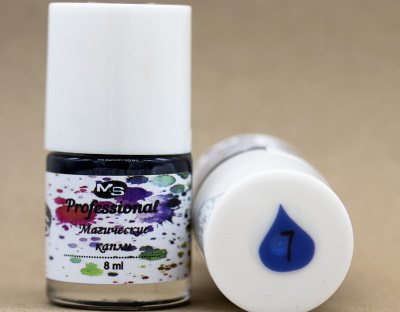
- artistic watercolor.
Despite the fact that the materials are used to create images of the same watercolor style, each of them has features in its application. Differences in the chemical composition and density of the material also determine the variety of effects.
Watercolor gel polish
These varnishes are the usual gels in bottles with a brush. Their feature is a chemical formula that allows pigments of different shades to interact. Spreading over the surface of the nail, they create patterns. A few drops spread into a composition visually similar to a flower or reptile skin. This depends on the size, location and volume of the drop.
The material is polymerized by exposure to ultraviolet rays on the photo-initiators it contains.
Acrylic paint
This material is a pigment (usually available in tubes) for painting. The paint is applied to a matte surface, dries in the open air, and dissolved with water. Acrylic paints diluted with water have the slowest drying speed. Nail technicians rarely use acrylic paints for watercolor painting in practice. Their density is more suitable for Chinese painting using flat brushes with an angled angle.
Gel polish
This is a colored nail coating that requires curing in a lamp. It may have varying degrees of pigment density depending on the manufacturer and the effect. The material has a wide palette of shades and is often used for painting. Watercolor painting on nails using conventional gel polishes is performed step by step with intermediate drying of each applied layer. Otherwise, the pigment will mix and create a feeling of untidiness.
This technique is considered the most difficult, since to create light and shade it is necessary to dilute densely pigmented gel polish with top coat or its other shades. You can make the task easier by using special patterns (stencils).
Paint for painting “Watercolor drops”
This is a colored liquid in a bottle with a brush. The basis of “Watercolor drops” is an alcohol solution. Thanks to this feature, they have a high drying rate on the surface and do not require polymerization. The liquid has a narrow palette (usually no more than 10-15 colors). However, by mixing shades you can get new colors.
You can create chaotic designs and textures with a brush from a bottle, without using additional tools. This is a big plus when designing at home.
Artistic watercolor in ditches
This is the most common form of watercolor. Its basis is pigment and plasticizers. It is available in most art stores. A wide palette of shades allows you to create designs of any complexity. It is sold in the form of briquettes or sets, activated by water.
There are several factors that repel beginners when using artistic paints in painting:
- selecting the right combination of water and pigment;
- adjusting the amount of paint on the brush;
- difficulties in distributing material in the right direction;
- low drying speed.
Features of background preparation
Perform a watercolor design on a prepared base, working with gel polish. Since coatings of this type have their own characteristics in application technology, initially a background is created for the design, following all the rules for its layer-by-layer implementation. It will be a kind of canvas for design.
When working, you will have to use a drying lamp, without which the compositions used will not dry.
First, prepare the nail, remove the cuticle and pterygium around it, give it the desired shape, and clean out everything unnecessary. Afterwards, the gloss is removed from the nail plate itself. After this, a layer of base, pigment and top is applied, each of them is dried immediately after application in a special lamp. After the topcoat has dried, the surface under the pattern is buffed (treated with a soft sander) to obtain a slightly rough surface. After this, you can paint on it with water-based paints.
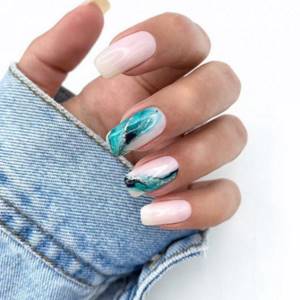
Pros and cons of coatings with a spreading effect
For ease of comparison, the lists of the main pros and cons of watercolor gel polishes are grouped into a table:
| pros | Minuses |
| Fast and easy to use | Inability to control material distribution |
| The similarity of the chemical formula with other materials used in leveling and modeling, therefore, better adhesion and wear. | A narrow list of drawings possible to create. It is not possible to create complex and realistic images. |
| Convenient packaging for storage | The material is suitable only for this technique |
| Water is not used for dilution as it reduces the quality of adhesion between the pattern and the top coat. | It is not possible to vary the shade, since the material may lose its properties when diluted. |
| After polymerization, there is no risk of the pattern being erased (blurred) when covering with topcoat. | High cost relative to other materials, rapid consumption. |
| Does not require additional activation or preparation. The material is ready for use immediately after opening the bottle. | Limited palette |
French
Light and graceful painting has captivated millions of fashionistas, and they never cease to come up with new ideas for combining watercolors with familiar manicure techniques. For example, many have already adopted the exquisite combination of picturesque drawings with classic French design.
Usually fashionistas don’t think long about which image to pair the jacket with in watercolor technique. The sophistication and grace of the traditional manicure style is perfectly combined with delicate floral motifs. A fashionable technique is to create watercolor accents on just a couple of nails.

“Wet on wet” manicure: how to work correctly with watercolor gel polishes?
The effect created by watercolor gel polishes is based on the interaction of an ideally selected chemical formula, percentage of pigment content and consistency. Therefore, it is preferable to choose materials from a series of one manufacturer. The most common mistake beginners make is typing material. It takes time to distribute the pigment over the base layer. The surface of the nail has an arched curve.
Excess material can drain under its own weight, forming streaks in the lateral sinuses and under the cuticle. This reduces the wear life of the material, causing the coating to peel off. The base color must be applied to the entire surface, avoiding bald spots. The layer should be very thin without leveling. For effective spreading of colored gel polish, there should be enough material on the brush.
Tools and materials needed to complete the design:
- 2 types of watercolor gel polish;
- thin brush or dots;
- lint-free wipes, dispersion remover;
- gel paint for drawing details and a hair brush.
What kind of drawings can you make?
Drawings on nails with watercolors can be very simple and unpretentious, or with a complex pattern. Each nail designer creates his own twist and unique pattern on the nail.
The spreading effect is especially popular. It can be used for any nail shape. But it is better to apply the pattern based on the length of the nail plate. For short nails, the best option would be a pattern that covers the entire surface - abstraction, sea images. On long nails, small multiple patterns or one large one - flowers, reptile skin, marble patterns - look impressive.
More photos and publications: Red and black design: techniques for creating a fashionable manicure
Design ideas could be the following:
Marine theme
The tones are mainly green-blue. It’s easy to draw - apply dots on the substrate in a chaotic order and let it spread freely. You can decorate it with an applique - an anchor, a fish, a ship, a shell, a starfish or a horse.
Reptile skin
The color scheme here can be varied - green, blue, pink, gray shades. They usually combine two colors that match the tone, creating the natural coloring of reptile skins - yellow with orange, gray with black. The drawing is applied in the same way as for a marine theme, but in a checkerboard pattern.
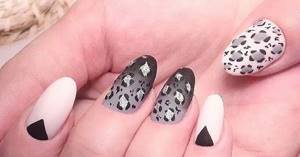
Abstract pattern
Here the designer's imagination has room to run wild. You can depict curls, chaotic lines, circles of different diameters. The color range here is as wide as possible. The photo below has many ideas for creating an abstract painting.
Floral design
Roses painted in one color look perfect against a dark background. There can be a wide variety of flowers on a light nail. They can be decorated with rhinestones or bouillons. The petals are drawn from a point to the center or in the reverse order, drawing out each petal with a thin brush. Poppies, daisies, dandelions, and irises look beautiful in this style.
Marble image
As with the reptile skin design, two shades of watercolor are used. These can be contrasting or similar colors. The “stone” pattern is made coarse or with veins.

Animals
Particularly popular among fashionistas are cats, dogs, birds and fish. They are a good addition to your everyday look, lifting your mood on weekdays. Ideas for drawings can be taken from children's books. Such patterns require high artistic talent from the master.
More photos and publications: Features of choosing the right top coat for gel polish
There are many design variations, it all depends on the imagination and talent of the nail artist. The more painstaking the work, the more skill and time it will take to create a unique image.
Steps to creating a watercolor design with a colored background
Designs with watercolor gel polishes look most vivid and rich on a white base. It is usually called the base, since it is applied first. For lovers of dark shades, some manufacturers produce a black base.
Watercolor on nails step by step with a base is done in stages:
- Use a lint-free cloth soaked in a degreaser to remove the dispersion layer remaining after leveling or modeling.
- Apply a thin, even layer of the base coat to the surface of the nail.
- A few drops or strokes of watercolor gel polish of the selected shade are applied to the undried substrate. The material needs a few seconds to distribute, after which it is sent to dry in a lamp.
- The result is secured with a top coat.
Abstraction
Complete freedom of creativity is given by design in the abstract style with its inherent versatility and individuality. Today, more and more fashionistas adhere to the principle of “not like everyone else” in manicure and choose an original manicure for self-expression.
Chaotic stains in watercolor technique are just such an option. It allows you to use several favorite colors and techniques at once, and does not limit the choice of decor. You can give free rein to your imagination and combine careless brush strokes with watercolor drops, geometry and gold accents. The power of abstract art lies in the ability to transform a couple of colored lines into a real work of art.

The trend for the 2022 season is a combination of watercolor painting with the “negative space” technique, which implies the presence of transparent areas in nail art. Also at the peak of popularity is a matte top for this design.
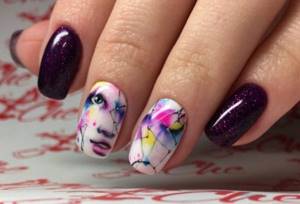
Interesting: Noble manicure
Steps for creating a watercolor design without a color base
In addition to colored watercolor gel polishes, manufacturers offer manicurists a spreading liquid. This is a transparent gel with liquid consistency. It can be applied to any color of gel polish that replaces the base, thereby expanding the variety of designs.
The transparency of the material allows for multi-layer designs. You can apply gel polish over an already completed design, complementing it, and also create nude designs, covering the camouflage with a transparent liquid.
Watercolor on nails step by step without a substrate is performed in stages:
- You need to apply the selected color coating or camouflage base to the nail (when leveling). Carry out a polymerization cycle in accordance with the manufacturer's instructions, remove the residual sticky layer.
- Apply a thin layer of spreading liquid. If necessary, you can first complete design elements with gel paint (flower stems, twigs, contours).
- Gel polish is applied to the wet base, allowed to spread and polymerized in a lamp.
- The design is complemented by repeating the procedure, otherwise it is immediately covered with a top coat.
The chemical composition of the liquid allows it to work with most conventional gel polishes, but the overall effect of the technique is slightly different.
Ah, the sea, the sea!
Summer is a great opportunity to create an exquisite manicure in a marine style. Trends in the world of nail art are gradually replacing the usual designs with stripes and anchors and making way for more artistic and exclusive nail art. We are talking about sea waves, embodied with the help of watercolors and complex transitions between shades.

The most fashionable type of marine manicure is a sophisticated combination of sea waves with a nude finish and metallic accents. This tandem looks sophisticated, discreet and incredibly stylish. A great idea for girls who are looking for a trendy summer nail art with excellent versatility!
Ombre
The ombre design based on a manicure with watercolors looks stylish and modern. If you want to be on the wave of fashion trends, choose nude and almost transparent tones to create a gradient effect. Also in trend are unobtrusive sparkles in ombre manicure. Look for inspiration for such an elegant design in the photo below.
Interesting: Ombre manicure: the most trendy new items!
Marble
The marble effect created using watercolors also remains in demand in the 2022 season.
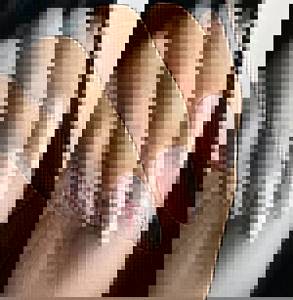
Interesting: Marble manicure: beautiful options
Advice from professionals
Professional nail technicians believe that the most important part of the job is practice. Therefore, advice No. 1 is a permanent internship in some specific topic dedicated to the manicure industry. At first, this can be done on tips, and then gradually move on to clients’ nails.
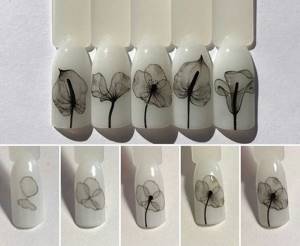
Learning to design using tips takes place without much effort, since the tips can be rotated in the way that is most convenient for the master to draw. That is why it is equally important to place your hand on real nails.
The most difficult thing in watercolor painting is drawing contours in complex sketches. And in order for the contours to be clear, you need to learn to hold your hand steady. The fingers of the person drawing should be resting on the finger (or tip) on which the line is drawn, and the elbow or forearm should be firmly on the work table. This will help beginners draw thin, clear lines.
In addition to drawing the contours, a significant point is the correct coating of the nail plate with color. The second, but no less important piece of advice is to constantly improve your skills and learn something new. The modern beauty industry does not stand still and therefore it is important for workers in this field to constantly improve their level of knowledge.
Watercolor painting in manicure design is quickly gaining popularity. And this technique is becoming a leading trend in the modern nail service industry because it does not require any additional investments and is not time-consuming. That is why in 2019 you can increasingly see this decoration technique on the nails of girls who follow trends.
Ideas for short length
A manicure with watercolors can also be done on short nails. Of course, such a length is unlikely to allow you to recreate complex landscapes and colorful compositions. The fact is that this design looks catchy, overloaded and difficult to perceive on short nails.
Watercolor stains in the stylish minimalism or abstraction technique will look advantageous. Manicures with floral designs have long ceased to be the prerogative of fashionistas with long nails. Laconic and cute design ideas look great on natural lengths. The main condition is moderation in palette and decor.
The matte finish, which looks stylish even on a short length, will help make watercolor drawings even more relevant.
Stamping stains on nails
Nowadays there is a huge selection of beautiful plates, varnishes, and stamps that can quickly be used to imprint a design on your nails. For example, the photo shows an interesting example of stamping, where the master played with the stains with a gradient, highlighting them with a bright combination of colors.
